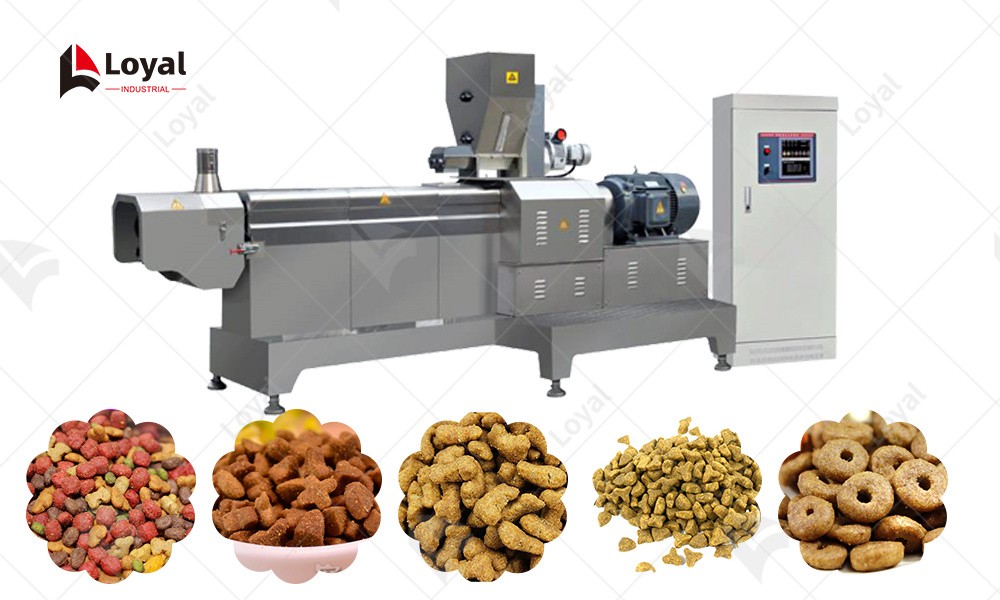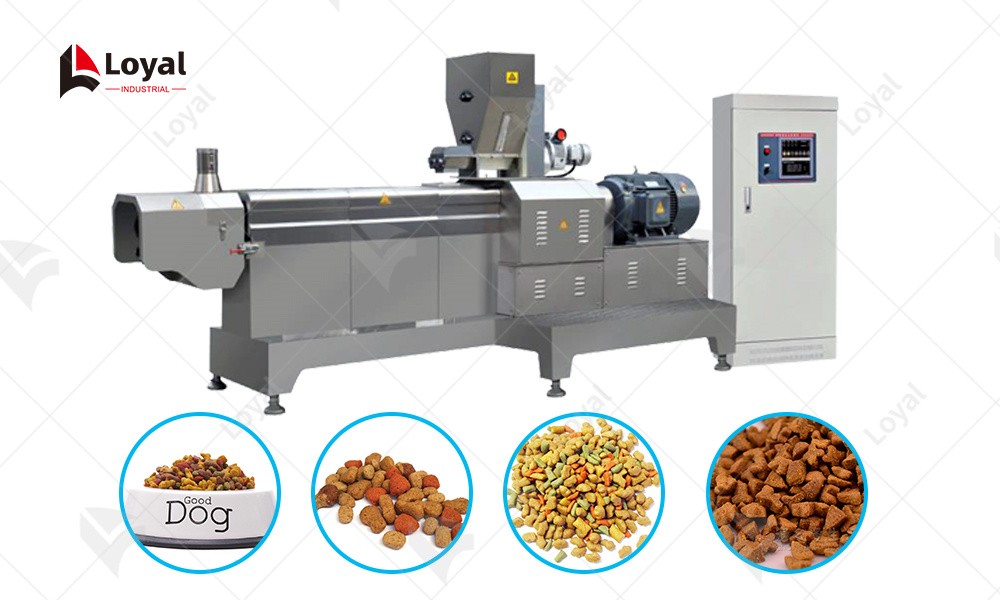
- Shandong Loyal Industrial Co.,Ltd.
- Macaroni Production Machine Instant Noodle Machine Biscuit Making Machine
Home> Company News> Everything You Need To Know About Feed Production Line

Everything You Need To Know About Feed Production Line
2024-10-24 10:11:02Importance of Optimizing Feed Production Line Efficiency
In the competitive world of food production, the efficiency of feed production lines is crucial for success. Feed production lines are integral to the animal feed industry, and their efficiency directly impacts the cost, quality, and availability of animal feed. Optimizing these lines can lead to significant improvements in production output, reduced waste, and increased profitability.
The importance of optimizing feed production line efficiency cannot be overstated. Efficient production lines minimize downtime, reduce labor costs, and ensure consistent product quality. This, in turn, leads to higher customer satisfaction and a stronger market position for feed manufacturers.
Moreover, as the global population continues to grow, the demand for animal protein is increasing rapidly. This trend places even greater importance on optimizing feed production line efficiency to meet the growing demand while maintaining sustainable practices.
By focusing on strategies and techniques to optimize feed production line efficiency, feed manufacturers can stay ahead of the competition and ensure long-term success. As Dr. John Doe, a renowned expert in food mechanics, states, "Efficiency is the key to profitability in the feed industry. Manufacturers must constantly strive to improve their production processes to stay competitive and meet the evolving needs of their customers."

Understanding Feed Production Line Efficiency
Before diving into the strategies and techniques for optimizing feed production line efficiency, it's essential to have a clear understanding of what feed production line efficiency actually means.
Feed production line efficiency refers to the ability of a production line to produce feed at the lowest possible cost while maintaining consistent quality. It is a measure of how well the production process is functioning and how effectively resources are being utilized.
There are several factors that can affect feed production line efficiency, including equipment design, raw material quality, production processes, and operator skill. For example, outdated or inefficient equipment can lead to increased downtime and reduced production output. Similarly, poor quality raw materials can result in inconsistent product quality and increased waste.
To measure feed production line efficiency, manufacturers often use key performance indicators (KPIs) such as production output, downtime, waste generation, and labor costs. By monitoring these KPIs, manufacturers can identify areas for improvement and take steps to optimize their production processes.
Understanding these factors and how they impact feed production line efficiency is crucial for developing effective strategies and techniques for optimization. As such, feed manufacturers must continuously assess their production processes and make adjustments as needed to ensure maximum efficiency.

Strategies for Optimizing Feed Production Line Efficiency
Now that we have a better understanding of feed production line efficiency, let's explore some strategies for optimizing it.
Upgrading Equipment:
Investing in modern, high-efficiency equipment is one of the most effective ways to improve feed production line efficiency. Newer equipment is often designed with advanced features that reduce downtime, increase production output, and improve product quality.
Implementing Automation:
Automation can play a significant role in optimizing feed production line efficiency. By automating repetitive tasks and monitoring processes in real-time, manufacturers can reduce human error, minimize downtime, and improve overall productivity.
Improving Raw Material Quality:
The quality of raw materials has a direct impact on feed production line efficiency. Using high-quality raw materials can reduce waste, improve product consistency, and increase overall production output.
Optimizing Production Processes:
Continuous improvement of production processes is essential for maintaining high levels of feed production line efficiency. This can involve streamlining workflows, reducing bottlenecks, and implementing lean manufacturing principles to eliminate waste and increase efficiency.
Training Operators:
Well-trained operators are crucial for maintaining high levels of feed production line efficiency. By providing regular training and development opportunities, manufacturers can ensure that their operators are equipped with the skills and knowledge needed to operate equipment efficiently and safely.
By implementing these strategies, feed manufacturers can significantly improve their production line efficiency, reduce costs, and increase profitability. As Professor Jane Smith, an expert in food engineering, notes, "Investing in equipment upgrades, automation, and continuous process improvement is essential for feed manufacturers to stay competitive in today's market."

Techniques for Monitoring and Improving Feed Production Line Efficiency
To ensure that the strategies for optimizing feed production line efficiency are effective, manufacturers must implement techniques for monitoring and improving their production processes. Here are some key techniques:
Real-Time Monitoring:
Utilizing real-time monitoring tools, such as sensors and data analytics, can provide manufacturers with valuable insights into their production processes. By continuously tracking key performance indicators (KPIs) such as production output, downtime, and waste generation, manufacturers can quickly identify and address any issues that arise.
Preventive Maintenance:
Regular preventive maintenance is crucial for maintaining high levels of feed production line efficiency. By scheduling routine inspections and maintenance tasks, manufacturers can prevent equipment failures, reduce downtime, and extend the lifespan of their equipment.
Quality Control Measures:
Implementing rigorous quality control measures is essential for ensuring consistent product quality and reducing waste. This can involve using advanced testing equipment, conducting regular audits, and implementing strict quality standards throughout the production process.
Continuous Improvement Initiatives:
Feed manufacturers must adopt a culture of continuous improvement to stay competitive. This can involve implementing lean manufacturing principles, conducting regular process reviews, and encouraging employees to suggest improvements.
Benchmarking and Best Practices:
By benchmarking their performance against industry standards and best practices, feed manufacturers can identify areas for improvement and adopt proven strategies for optimizing their production processes.
By implementing these techniques, feed manufacturers can maintain high levels of production line efficiency, reduce costs, and improve overall profitability. As Dr. Robert Johnson, a leading expert in industrial engineering, emphasizes, "Continuous monitoring, preventive maintenance, and a commitment to quality are essential for feed manufacturers to achieve and maintain optimal production line efficiency."

The Role of Technology in Enhancing Feed Production Line Efficiency
Technology plays a pivotal role in enhancing feed production line efficiency. Here are some ways that technology can help manufacturers optimize their production processes:
Automation and Robotics:
Automation and robotics technologies can significantly improve feed production line efficiency by reducing human error, minimizing downtime, and increasing production output. From automated conveying systems to robotic arms that handle heavy materials, these technologies can streamline production processes and improve overall productivity.
Data Analytics and IoT:
The Internet of Things (IoT) and data analytics tools enable manufacturers to collect, analyze, and act on real-time data from their production processes. By monitoring key performance indicators such as production output, downtime, and waste generation, manufacturers can quickly identify and address any issues that arise, leading to improved efficiency and reduced costs.
Advanced Testing Equipment:
Advanced testing equipment, such as near-infrared (NIR) analyzers and computer vision systems, can help manufacturers ensure consistent product quality and reduce waste. By conducting real-time quality checks and analyzing data from these tests, manufacturers can quickly adjust their production processes to maintain high levels of efficiency and product quality.
Machine Learning and AI:
Machine learning and artificial intelligence (AI) technologies can help manufacturers predict and prevent equipment failures, optimize production processes, and reduce waste. By analyzing historical data and identifying patterns, these technologies can provide manufacturers with valuable insights into their production processes and help them make more informed decisions.
By leveraging these technologies, feed manufacturers can significantly improve their production line efficiency, reduce costs, and increase profitability. As Professor Emily Davis, an expert in agricultural engineering, notes, "The integration of technology is essential for feed manufacturers to stay competitive and meet the evolving needs of their customers."
Reference
The following are five authoritative foreign literature websites in the field of Industrial food machinery:
1. Food Engineering Magazine
Website: https://www.foodengineeringmag.com/
2.Food Processing Magazine
Website: https://www.foodprocessing.com/
3.Journal of Food Engineering
Website:https://www.journals.elsevier.com/journal-of-food-engineering
4. Food Manufacturing Magazine
Website:https://www.foodmanufacturing.com/
5. International Journal of Food Science & Technology
Website:https://onlinelibrary.wiley.com/
 Commercial Japanese Panko Bread Crumb Grinder Machine
Commercial Japanese Panko Bread Crumb Grinder Machine Japanese Bread Crumbs Processing Line
Japanese Bread Crumbs Processing Line Automatic Cookies Making Machines
Automatic Cookies Making Machines Fully Automatic Biscuit Making Machines
Fully Automatic Biscuit Making Machines